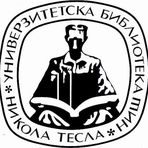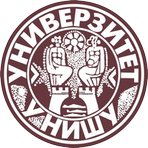Title
Klinički tok karcinoma jajnika u zavisnosti od patohistoloških i imunohistohemijskih karakteristika tumora : doktorska disertacija
Creator
Conić, Irena 1979-
Copyright date
2014
Object Links
Select license
Autorstvo-Nekomercijalno-Deliti pod istim uslovima 3.0 Srbija (CC BY-NC-SA 3.0)
License description
Dozvoljavate umnožavanje, distribuciju i javno saopštavanje dela, i prerade, ako se navede ime autora na način odredjen od strane autora ili davaoca licence i ako se prerada distribuira pod istom ili sličnom licencom. Ova licenca ne dozvoljava komercijalnu upotrebu dela i prerada. Osnovni opis Licence: http://creativecommons.org/licenses/by-nc-sa/3.0/rs/deed.sr_LATN Sadržaj ugovora u celini: http://creativecommons.org/licenses/by-nc-sa/3.0/rs/legalcode.sr-Latn
Language
Serbian
Cobiss-ID
Theses Type
PhD thesis
Other responsibilities
mentor
Stanojević, Zorica
član komisije
Vrbić, Svetislav
član komisije
Janković-Veličković, Ljubinka
član komisije
Jovanović, Darjana
član komisije
Krstić, Miljan
Academic Expertise
Medicinske nauke
University
Univerzitet u Nišu
Faculty
Medicinski fakultet
Group
Katedra za ginekologiju sa akušerstvom
Title translated
CLINICAL COURSE OF OVARIAN CARCINOMA DEPENDING ON PATOHISTOLOGICAL AND IMMUNOHISTOCHEMICAL CHARACTERISTICS
Publisher
Niš : [I. Conić]
Format
PDF/A (175 listova)
description
Umnoženo za odbranu.
Univerzitet u Nišu, Medicinski fakultet., 2014.
Bibliografija: listovi 143-172.
Beleška o autoru: list 175.
Sažetak ; Summary.
Abstract (en)
Introduction: According to the frequency of malignant tumours in the world, ovarian
carcinoma takes the eighth place; it is also the fifth most frequent tumour in women and the
fourth cause of cancer death in women. In early discovering and treatment of ovarian
carcinoma, before it expends out of the primary localisation, the five-year relative survival
rate is 92%. Unfortunately, only 15% of all ovarian carcinomas are discovered in the early
stage. It has been noticed that the survival rate is higher in women under the age of 65 than in
the older ones and it varies depending on the morphological type of ovarian carcinoma,
patient’s over-all health condition and the stage of the disease diffusion at the time of setting
the diagnosis. The exact cause of ovarian carcinoma occurrence is still unknown, but many
risk factors are related to the occurrence of this malignoma.
The aim of this research was to analyze the clinical and pathological characteristics of
ovarian carcinoma, as well as to determine Nanog, Sox2, Oct3/4, Sox4, CD44. CD117, Ezh2
and Stat3 expressions in paraffin sections of ovarian carcinoma and to compare the Nanog,
Sox2, Oct3/4, Sox4, CD44, Ezh2 and Stat3 expressions with the clinical and pathological
characteristics of ovarian carcinoma.
Methods: During the research, the immunohistochemical method was applied.
Paraffin sections of the tissue of ovarian carcinoma 5μm thick were used.
Conclusion: Unfavourable clinical course of ovarian carcinoma was related to the
positive Nanog, Sox2 and Oct3/4 expression, as well as with the absence or low expression of
Sox4, CD117 and CD44, while the loss of Ezh2 and Stat3 expressions in ovarian carcinoma,
indicated significantly longer survival.
Authors Key words
Karcinom jajnika, Nanog, Sox2, Oct3/4, Sox4, CD44, CD117, Ezh2,
Stat3
Authors Key words
ovarian carcinoma, Nanog, Sox2, Oct3/4, Sox4, CD44. CD117, Ezh2,
Stat3
Classification
618
Type
Elektronska teza
Abstract (en)
Introduction: According to the frequency of malignant tumours in the world, ovarian
carcinoma takes the eighth place; it is also the fifth most frequent tumour in women and the
fourth cause of cancer death in women. In early discovering and treatment of ovarian
carcinoma, before it expends out of the primary localisation, the five-year relative survival
rate is 92%. Unfortunately, only 15% of all ovarian carcinomas are discovered in the early
stage. It has been noticed that the survival rate is higher in women under the age of 65 than in
the older ones and it varies depending on the morphological type of ovarian carcinoma,
patient’s over-all health condition and the stage of the disease diffusion at the time of setting
the diagnosis. The exact cause of ovarian carcinoma occurrence is still unknown, but many
risk factors are related to the occurrence of this malignoma.
The aim of this research was to analyze the clinical and pathological characteristics of
ovarian carcinoma, as well as to determine Nanog, Sox2, Oct3/4, Sox4, CD44. CD117, Ezh2
and Stat3 expressions in paraffin sections of ovarian carcinoma and to compare the Nanog,
Sox2, Oct3/4, Sox4, CD44, Ezh2 and Stat3 expressions with the clinical and pathological
characteristics of ovarian carcinoma.
Methods: During the research, the immunohistochemical method was applied.
Paraffin sections of the tissue of ovarian carcinoma 5μm thick were used.
Conclusion: Unfavourable clinical course of ovarian carcinoma was related to the
positive Nanog, Sox2 and Oct3/4 expression, as well as with the absence or low expression of
Sox4, CD117 and CD44, while the loss of Ezh2 and Stat3 expressions in ovarian carcinoma,
indicated significantly longer survival.
“Data exchange” service offers individual users metadata transfer in several different formats. Citation formats are offered for transfers in texts as for the transfer into internet pages. Citation formats include permanent links that guarantee access to cited sources. For use are commonly structured metadata schemes : Dublin Core xml and ETUB-MS xml, local adaptation of international ETD-MS scheme intended for use in academic documents.


